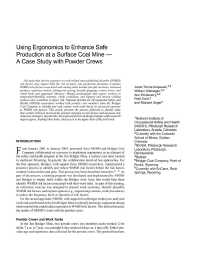Mining Publication: Using Ergonomics To Enhance Safe Production At a Surface Coal Mine - A Case Study With Powder Crews
Original creation date: October 2009
Job tasks that involve exposure to work-related musculoskeletal disorder (WMSD) risk factors may impact both the risk of injury and production downtime. Common WMSD risks factors associated with mining tasks include forceful exertions, awkward postures, repetitive motion, jolting and jarring, forceful gripping, contact stress, and whole body and segmental vibration. Mining environments that expose workers to temperature/humidity extremes, windy conditions, and slippery and uneven walking surfaces also contribute to injury risk. National Institute for Occupational Safety and Health (NIOSH) researchers worked with powder crew members from the Bridger Coal Company to identify and rank routine work tasks based on perceived exposure to WMSD risk factors. This article presents the process followed to identify tasks that workers believed involved the greatest exposure to risk factors and discusses risk reduction strategies. Specifically, the proposed prill truck design changes addressed cab ingress/egress, loading blast holes, and access to the upper deck of the prill truck.
Authors: J Torma-Krajewski, WJ Wiehagen, A Etcheverry, FC Turin, RL Unger
Peer Reviewed Journal Article - October 2009
NIOSHTIC2 Number: 20035693
J Occup Environ Hyg 2009 Oct; 6(10):D55-D62
See Also
- Ergonomic Interventions at Vulcan Materials Company
- Ergonomics Processes: Implementation Guide and Tools for the Mining Industry
- Ergonomics: Beyond Compliance
- Human Factors in Mining
- Implementation of an Ergonomics Process at a US Surface Coal Mine
- Musculoskeletal Stress on Miners Performing Roof Screening Operations
- Physical Strength Assessment in Ergonomics
- Practical Demonstrations of Ergonomic Principles
- Reducing Low Back Pain and Disability in Mining
- Strength Testing
- Content source: National Institute for Occupational Safety and Health, Mining Program


 ShareCompartir
ShareCompartir
